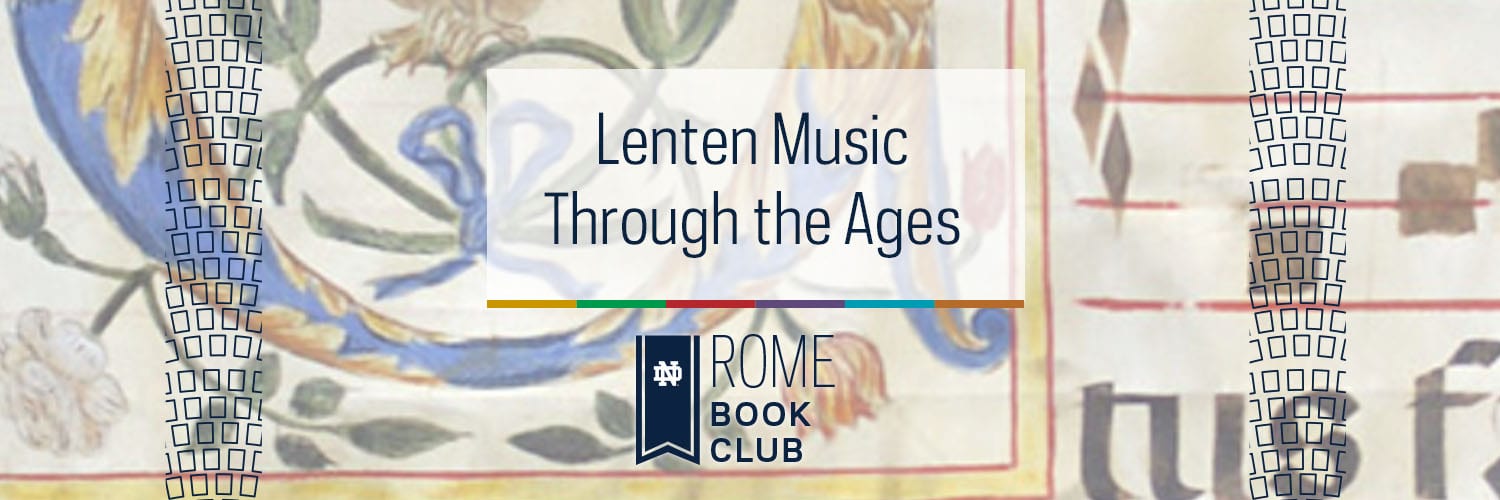Week 3 - All Together Now: Sacred Music of the Baroque

In the late 16th and early 17th centuries, the tides of sacred music began to turn. Reformation ideals shaped much of the music in northern Europe, and these changes were matched by a growing Counter-Reformation movement in Italy, especially in Rome. Church leaders began placing a renewed emphasis on clarity in sacred music, which contributed to the growing repertoire of homophonic music. This was a time not unlike our own post-Vatican II church, where questions of openness and accessibility found a seat at the table next to tradition, hierarchy, and authority.
Baroque Music and Religious Devotion in 17th Century Rome
Presented by J.J. Wright
In this video, we’ll talk through some of the general attributes of Baroque music, as well as how this music contributed to a renewed religious devotion in Rome during the 17th century.
From Polyphony to Homophony
Presented by J.J. Wright
How does the transition from the lush and ethereal sounding Renaissance Polyphony of last week to the very direct and tightly structured feeling of the Baroque happen?
To get to Baroque music, we need to start in 1545 with the Council of Trent, which had far reaching consequences on the whole Church, and most definitely on sacred music. The Council of Trent was an ecumenical council, meaning bishops and church thinkers traveled from all over Europe and the world to clarify matters related to doctrine (original sin, sacred tradition, etc.) and practice (the Mass, sacraments, etc.).
One great example of the way Trent codified or clarified practices was the resulting Tridentine Mass, which was established soon after the Council and would remain the primary form for the celebration of the Roman Catholic Mass until the Second Vatican Council. With this codification, sacred music now had a speedier path for development. By legislating that the same texts be used, and used functionally, within the liturgy for such a long period of time, composers and practitioners of sacred music were able to be exposed to many more varied types of sacred music in a shorter period of time.
One of the main things Trent prioritized for religious art was clarity and intelligibility. This didn’t bode well for the continued flourishing of the type of polyphony we heard last week, which though beautiful, is not easily comprehensible.
Around the turn of the 17th century, the new baroque style began to spread through sacred and secular music alike. One of its main features was the increased use of accompaniment that is separate from the vocal parts. Music now had its own “rhythm section” that covered the bass and harmony parts, which in turn made it possible to free up the voices to deliver the text in a clear and direct way. The result in sacred music is a lot more accompanied homophony (two or more voices singing together in harmony, but largely in the same rhythm) and monody (a single melody line singing with accompaniment).
In the sacred music tradition, the 17th century also brought with it the oratorio, which is a dramatic musical setting of a sacred text or story. Oratorios found an early home in Rome as an outgrowth of the Counter-Reformation efforts of St. Phillip Neri and his Oratory. What started as small groups for sharing scripture, song, and fellowship became a catalyst for creativity in sacred music drama. The most famous example of the oratorio tradition, of course, is Handel’s “Messiah,” which has completely pervaded the popular imagination and is sung around the world every December. It’s incredible to think about how powerful one little movement can be. The example of the “Messiah” and of how sacred music can joyfully share the good news across the world is one that really inspires me.
Listening Example 1
Presented by J.J. Wright
This listening example comes from one of the first oratorios. An oratorio is a dramatic musical setting of a sacred text. Listen to how different the vocal style is from the polyphonic singing of last week. There is an expanded dynamic range because of the unity of voices — also, notice that this music is in Italian, our first example not in Latin.
Listening Example 2
Presented by J.J. Wright
If you have time, go back and listen to the Christus factus est chant from our first week after you listen to this one.
The text of Christus Factus Est (literally “Christ is made for us”) is taken from St. Paul’s Letter Epistle to the Philippians and is sung during the liturgies of the paschal triduum. Meditate on the words while you listen:
Christus factus est pro nobis obediens
usque ad mortem, mortem autem crucis.
Propter quod et Deus exaltavit illum et dedit illi nomen,
quod est super omne nomen
Christ became obedient for us unto death,
even to the death, death on the cross.
Therefore God exalted Him and gave Him a name
which is above all names.
View the Event
Presented by J.J. Wright
Subscribe to the ThinkND podcast on Apple, Spotify, or Google.
Featured Speakers:
- J.J. Wright ’14, Director, Notre Dame Folk Choir
- Patrick Kronner, Organist and Choral Program Director at the University of Notre Dame, Director of the Magnificat Choir
Additional Resources
Presented by J.J. Wright
- Bach’s St. Matthew Passion
- Peter Sellars Interview on staged Bach St. Matthew Passion (best part is from 22’-31’)
